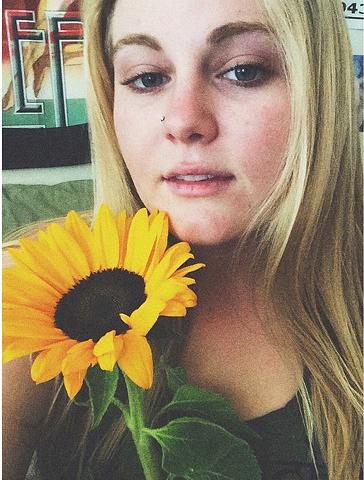Monday, November 07, 2016
A Permaculture Perspective - What is Permaculture?
 Popular Guest Blogger Emma Samuelson is back with a hot topic - Permaculture!
Popular Guest Blogger Emma Samuelson is back with a hot topic - Permaculture! Emma is a recent college graduate from California who writes her own songs, sings and plays guitar. Check out the excellent music and ASL videos on her YouTube channel! In Emma's own words, "I am a spiritual person and I love music, listening to it, creating it, and everything about it." Her love of music is obvious in her videos!
Please use this link to see a list of ALL guest blog posts by Emma Samuelson.
Emma just started getting involved in the world of Permaculture this year. What IS Permaculture? How is it good for us and for the environment? Emma tells us what Permaculture is, and shows us 3 videos that answer the question, What is Permaculture!
A Permaculture Perspective
Beginning in April of this year, I began a journey of learning and practicing permaculture as a way of life. It turned out to be my practice of connecting back to the earth, and after living from a permaculture perspective this summer, I will never look back. As a garden intern at a hot springs community in Southern Oregon, I worked in our garden every day growing vegetables, fruit, herbs, and medicinal plants that fed and nourished our local community of residents, visitors and friends. I learned how to plant seeds, tend them as they grew, harvest and process food, as well as how to take proper care of the earth and environment around me as I did it. Not only did we study the practice of farming and gardening, but we also delved deep into permaculture design and applied it to our practices of growing food.Permaculture, which reflects the concept of "permanent agriculture”, is the conscious based design and maintenance of cultivated ecosystems. It is a solution based outlook that utilizes harmonious appropriate technologies, efficient modes of energy, and provides goods, shelter, and other needs in a sustainable way. One of the goals of permaculture is regenerative designs that honor earth care, people care and fair share of resources. In comparison to industrial farming, permaculture not only provides people with better food and resources, but also decreases environmental damage immensely... permaculture works with the earth and its soil rather than depleting its beneficial value.
What is Permaculture?
In this short documentary, Ana Sany and Jacob Redman interview countless people involved in permaculture design and practice asking them “What is Permaculture?” This is just a brief introduction to permaculture and how it can impact various people around the world. The interviewees include Pandora Thomas, a well known permaculture professor from the Bay Area, Rosemary Morrow, known as one of the pioneering women of permaculture based in Australia, and John Champagne, another pioneer of the Permaculture Movement in Australia.
Permaculture is a way of life.
As you can tell, permaculture is more than just a way of gardening, it’s a way of life, it’s a movement that is at the forefront of environmental science and social justice. Permaculture branches out into many different areas including agriculture, environmental science, food science, and even government and politics. In particular, I’m very excited about diving deeper into the connection between permaculture and sociology, looking at how we are as a society can benefit and grow from adopting a permanent regenerative design for gardening and farming. Starhawk, a well known writer and activist, recently did a Social Permaculture Conference along side Pandora Thomas, which a few of my friends attended. Starhawk is very influential in many different networks and has a lot to offer in the world of sustainable living and connection to the earth. In the following video, pre-conference, Starhawk discusses some of what she believes Social Permaculture is.
Permaculture restores Mother Nature.
As Starhawk said here, “permaculture is the art of designing beneficial relationships, it’s a system of ethical, ecological design.” I truly believe that permaculture is the way to resurrect the soil we walk upon, it is the way to restore mother nature and allow ecosystems to flourish naturally, it is the way to consciously feed our communities. There are many different Permaculture institutes and classes you can take all around the country, including courses that provide you with a full permaculture education resulting in a Permaculture Design Certificate (PDC). By getting your PDC, you can go on to pursue further education, practice and get involved in global projects to help support sustainable living and regenerative design. After getting the basics down, I am currently on the road to getting my PDC and giving back to the earth that has given so much to me.
As a twenty two year old in the technology era, I am so incredibly proud to say I can grow my own food. I can make compost, I can grow vegetables and herbs and preserve them, I can cook, I can chop wood and build fires... I can feed myself, from seed to skillet, which is a skill I will have for the rest of my life. One of the films that truly helped me to learn more and understand what having a permaculture perspective is, came out last year and is entitled INHABIT. It is an incredible documentary that interviews a variety of people, groups and communities that practice permaculture in daily life. It is a well crafted and informative documentary that changed the way I looked at agriculture and farming. I highly recommend watching it and learning more about how you can be a part of this amazing movement. Here is the trailer, just to give you a taste of how permaculture can better our world and the way we work with it.
Read more about Permaculture on Steemit.
Labels: "Emma Samuelson", Emma Samuelson, emmalane94, Food, gardening, nature, permaculture
YouTube™ is a trademark of YouTube, LLC.
YouTubeStars and YouTube are not affiliated in any way.




